BAG-6 is essential for selective elimination of defective proteasomal substrates
- PMID: 20713601
- PMCID: PMC2928017
- DOI: 10.1083/jcb.200908092
BAG-6 is essential for selective elimination of defective proteasomal substrates
Abstract
BAG-6/Scythe/BAT3 is a ubiquitin-like protein that was originally reported to be the product of a novel gene located within the human major histocompatibility complex, although the mechanisms of its function remain largely obscure. Here, we demonstrate the involvement of BAG-6 in the degradation of a CL1 model defective protein substrate in mammalian cells. We show that BAG-6 is essential for not only model substrate degradation but also the ubiquitin-mediated metabolism of newly synthesized defective polypeptides. Furthermore, our in vivo and in vitro analysis shows that BAG-6 interacts physically with puromycin-labeled nascent chain polypeptides and regulates their proteasome-mediated degradation. Finally, we show that knockdown of BAG-6 results in the suppressed presentation of MHC class I on the cell surface, a procedure known to be affected by the efficiency of metabolism of defective ribosomal products. Therefore, we propose that BAG-6 is necessary for ubiquitin-mediated degradation of newly synthesized defective polypeptides.
Figures
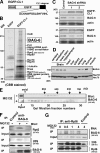
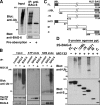
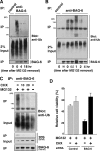
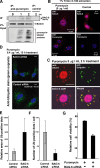
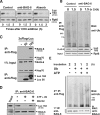

Similar articles
-
BAG6/BAT3: emerging roles in quality control for nascent polypeptides.J Biochem. 2013 Feb;153(2):147-60. doi: 10.1093/jb/mvs149. Epub 2012 Dec 28. J Biochem. 2013. PMID: 23275523 Review.
-
Autophagy inhibition promotes defective neosynthesized proteins storage in ALIS, and induces redirection toward proteasome processing and MHCI-restricted presentation.Autophagy. 2012 Mar;8(3):350-63. doi: 10.4161/auto.18806. Epub 2012 Mar 1. Autophagy. 2012. PMID: 22377621
-
A conserved island of BAG6/Scythe is related to ubiquitin domains and participates in short hydrophobicity recognition.FEBS J. 2016 Feb;283(4):662-77. doi: 10.1111/febs.13618. Epub 2015 Dec 31. FEBS J. 2016. PMID: 26663859
-
Ubiquitylation of BAG-1 suggests a novel regulatory mechanism during the sorting of chaperone substrates to the proteasome.J Biol Chem. 2002 Nov 29;277(48):45920-7. doi: 10.1074/jbc.M204196200. Epub 2002 Sep 23. J Biol Chem. 2002. PMID: 12297498
-
Assembly and function of the proteasome.Methods Mol Biol. 2012;832:315-37. doi: 10.1007/978-1-61779-474-2_22. Methods Mol Biol. 2012. PMID: 22350895 Review.
Cited by
-
Nuclear BAG6-UBL4A-GET4 complex mediates DNA damage signaling and cell death.J Biol Chem. 2013 Jul 12;288(28):20547-57. doi: 10.1074/jbc.M112.443416. Epub 2013 May 30. J Biol Chem. 2013. PMID: 23723067 Free PMC article.
-
A molecular triage process mediated by RING finger protein 126 and BCL2-associated athanogene 6 regulates degradation of G0/G1 switch gene 2.J Biol Chem. 2019 Oct 4;294(40):14562-14573. doi: 10.1074/jbc.RA119.008544. Epub 2019 Aug 1. J Biol Chem. 2019. PMID: 31371451 Free PMC article.
-
BAG-6, a jack of all trades in health and disease.Cell Mol Life Sci. 2014 May;71(10):1829-37. doi: 10.1007/s00018-013-1522-y. Epub 2013 Dec 4. Cell Mol Life Sci. 2014. PMID: 24305946 Free PMC article. Review.
-
Interactome profile of the host cellular proteins and the nonstructural protein 2 of porcine reproductive and respiratory syndrome virus.PLoS One. 2014 Jun 5;9(6):e99176. doi: 10.1371/journal.pone.0099176. eCollection 2014. PLoS One. 2014. PMID: 24901321 Free PMC article.
-
Protein targeting and degradation are coupled for elimination of mislocalized proteins.Nature. 2011 Jul 10;475(7356):394-7. doi: 10.1038/nature10181. Nature. 2011. PMID: 21743475 Free PMC article.
References
-
- Anton L.C., Yewdell J.W., Bennink J.R. 1997. MHC class I-associated peptides produced from endogenous gene products with vastly different efficiencies. J. Immunol. 158:2535–2542 - PubMed
-
- Banerji J., Sands J., Strominger J.L., Spies T. 1990. A gene pair from the human major histocompatibility complex encodes large proline-rich proteins with multiple repeated motifs and a single ubiquitin-like domain. Proc. Natl. Acad. Sci. USA. 87:2374–2378 10.1073/pnas.87.6.2374 - DOI - PMC - PubMed
Publication types
MeSH terms
Substances
LinkOut - more resources
Full Text Sources
Other Literature Sources
Molecular Biology Databases
Research Materials

